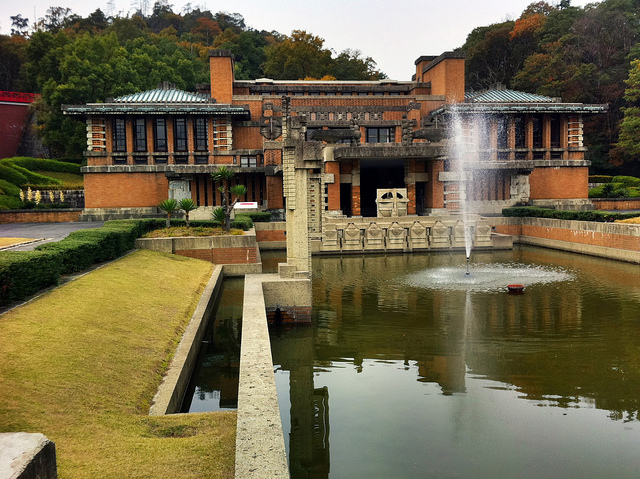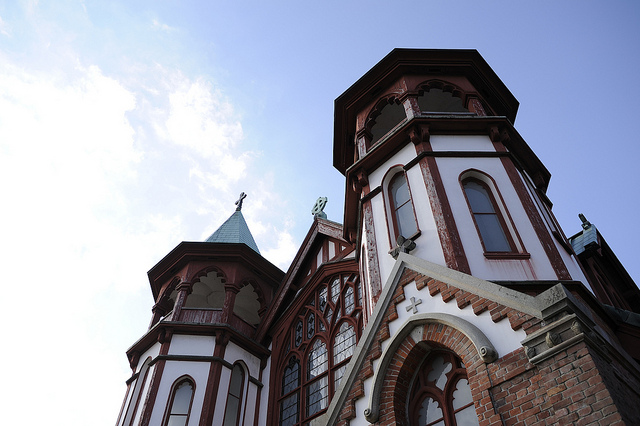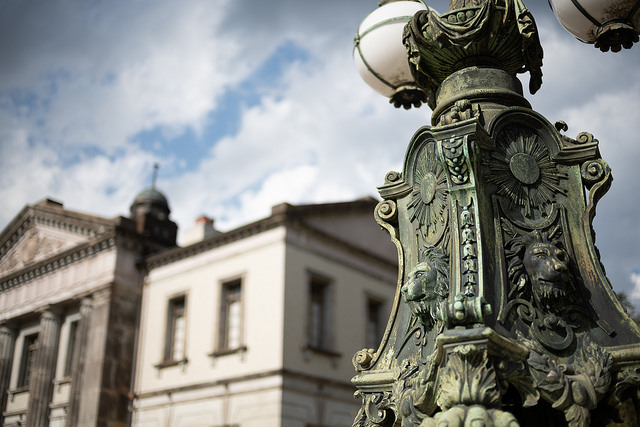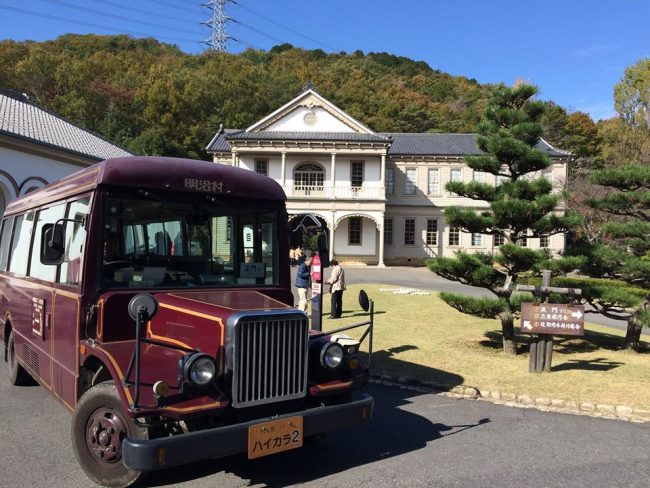Sep 30, 2015
Take a Journey Through Time at Meiji Mura
Have you aver wanted to travel back in time, to see what life was like in another era? Well, at Meiji Mura you can do just that.
Overlooking picturesque lake Iruka, Meiji Mura (meaning ‘Meiji Village) is an open-air museum on the outskirts of Inuyama. It is home to over sixty buildings sourced from all around Japan and lovingly restored, coming together to create a land that time not only forgot, but in fact even tried to destroy, and now stands as a timeless museum that is entertaining for history buffs, Japanophiles, the whole family, or anyone who just wants a nice day out.
What was the Meiji Period?
The Meiji Period (1867–1912) was a time of great transition for Japan. It marks the era in which the nation moved away from its feudal past and towards a westernized notion of law and governance. The rule of the of the samurai had come to an end and the opening of Japan’s borders to allow international trade ended hundreds of years of isolation. In doing so, the aesthetic of the country shifted dramatically.

The architecture was greatly influenced by western buildings, and many examples of this literal representation of the assimilation of Western and Eastern technological cultures can be seen today at the open-air museum that is Meiji Mura (博物館明治村 Hakubutsukan Meiji-mura).
What is Meiji Mura?
Following the ideological shift in Imperial Japan under Emperor Hirohito (Showa), many of the older brick and stone buildings from the Meiji period were being torn down to make way for the advancement of newer buildings, as they stood a testament to the western leanings of the Meiji era, something that the ruling elite wished to deny as war with the west became increasingly inevitable. Later, in the post-war years, this dismantling of Meiji buildings continued apace as city planners sought to develop a more modern Japan.

Having been greatly distressed by the destruction of Tokyo’s Rokumeiekan building in 1941, perhaps the predominant symbol of the Meiji era’s dalliance with western-style construction, architect Yoshiro Taniguchi petitioned his friend and then vice president of the Nagoya Railroad (Meitetsu), Motoo Tsuchikawa, to assist him in rescuing some of these historical buildings. In 1962 a foundation was formed and using funds provided by Nagoya Railroad, the pair set to the task of finding and then relocating the buildings for their theme park-like museum.
What you can find at Meiji Mura?
Taniguchi and Tsuchikawa succeeded in rescuing and preserving buildings of particular cultural value from all over Japan and even from places as far-flung as Hawaii, Seattle and Brazil. The buildings are set out into five zones amongst the one million square meter grounds, and are representative of all parts of Meiji era life, from schools to police boxes, from butchers to a kabuki theatre, the latter still functioning for its original purpose and is one of the ten buildings designated as an important cultural property. Other attractions of interest include a prison from Kanazawa, a bath house from Handa and a steam locomotive train.

You can ride a Kyoto street car or hop on a bus to take you to the various parts of the museum. Literary enthusiasts will enjoy wandering around the house of famed author Natsume Soseki and the number of cat statues within (a reference to Soseki’s novel ‘I am a Cat) or the former summer residence of spooky writer Lafcadio Hearn, while lovers of 1920s American architecture will marvel at the unique lobby of the Frank Lloyd Wright designed Imperial Hotel.

St. Francis Xavier’s Cathedral still provides a wedding ceremony service and a sake brewery holds tasting sessions on special days. Most of the buildings are furnished or hold interesting exhibitions illustrating daily life, and during days of good weather it is pleasant to simply wander the authentically-period gardened grounds for a day.
Meiji Mura details
- Where: 1 Uchiyama, Inuyama, Aichi (map)
- When: 9:30 to 17:00 (March to October), 9:30 to 16:00 (November), 10:00 to 16:00 (December to February). Closed Mondays from December to February
- Cost: Adult admission: 1700 JPY. Unlimited rides on the village bus, tram and train: 1000 JPY
- Website: www.meijimura.com
- Getting there: There is a bus service available from Inuyama train station. See here for details.
Mark Guthrie
Image: by Mark Guthrie (Own Work)
Image: by Al Case via flickr.com [CC BY-NC-ND 2.0]
Image: by joevare via flickr.com [CC BY-NC-ND 2.0]
Image: by Bong Grit via flickr.com [CC BY-NC-ND 2.0]
Image: by Bong Grit via flickr.com [CC BY-NC-ND 2.0]
Sep 11, 2015
Watching the Rugby World Cup in Tokyo
 Whether you are a dyed in the wool ‘egg chaser’, or totally new to the sport, now is the time to get really interested in rugby. With origins going as far back as ancient Greece, it gained popularity and codification in Victorian era Britain, and is enjoyed all over the globe. Right now fans of the sport are enjoying the Rugby World Cup 2015, which kicked off on September 18 and ends on October 31.
Whether you are a dyed in the wool ‘egg chaser’, or totally new to the sport, now is the time to get really interested in rugby. With origins going as far back as ancient Greece, it gained popularity and codification in Victorian era Britain, and is enjoyed all over the globe. Right now fans of the sport are enjoying the Rugby World Cup 2015, which kicked off on September 18 and ends on October 31.
Taking place in England*, the sport’s spiritual home, the World Cup is being competed between 20 teams; from the minnows of Uruguay and U.S.A. to the undisputed favourites, the All Blacks of New Zealand. One of the lower ranked teams that has already made a big impression is Japan, shocking the rugby world with a surprise victory over the Springboks of South Africa in a game that has been described by some as the most entertaining in the history of the tournament.
So, whether the Rugby World Cup in has been indelibly inked on to your diary, or you just want to get a jump on those Johnny-come-latelys in 2019, you’ll probably want to know which bars in the capital are showing it.
*Due to being held in a nation that is currently eight hours behind JST, venues may be showing games ‘as live’. Contact bars for exact details.
Hobgoblin
If you want watch a British sport, its probably best to watch it in a British Pub, particularly when this year’s hosts are second favourite to lift the Webb Ellis Trophy. Hobgoblin has three locations serving award winning craft ales, ciders and lagers and most games will be shown live with next day replays.
- Where: Akasaka – B1, Tamondo Building, 2-13-19 Akasaka, Minato-ku
Roppongi- 1F, Aoba Roppongi Bdg, 3-16-33, Roppongi,Minato-ku
Shibuya- 3/F, Ichiban Building, 1-3-11, Dogenzaka, Shibuya-ku - When: Monday – Friday 5pm – Late; Weekends & Holidays Noon – Late
- Website: www.hobgoblin.jp
The Hub
Pretty much wherever you turn around in Tokyo you can find a branch of one of these ubiquitous British pubs. They have plenty of screens which show sports almost any time of the day. However, baseball most definitely takes precedence, and if it is not a Japan game, don’t necessarily expect to be able to hear it.
- Where: All over the city
- When: Check with individual bars for details.
- Website: www.pub-hub.com
The Footnik
The sign outside of this British Pub reads “Respect all football fans” and that seems to refer not only to supporters of Association Football (soccer) but also to fans of Rugby Football. Showing up to six soccer games in one day, often simultaneously, the Ebisu location of this chain is a great place to watch sports, but do confirm that any rugby games do not clash with big soccer games.
- Where: Asahi bldg 1-11−2 Ebisu, Shibuya-ku
- When: 3pm-1am everyday
- Website: www.footnik.net
Legends Sports Bar
Perhaps Tokyo’s preeminent American sports bar, Legends has a plenty of screens, all of which are purposefully placed for viewing, no matter where you sit or stand. It’s a relatively small place, but that just adds to the atmosphere.
- Where: Aoba Roppongi Bldg 1F, 3-16-33, Roppongi, Minato-ku
- When: Monday – Friday 17:00-Late; Saturday Sunday & Holidays 14:00-Late (except live sports showing)
- Website: www.legendsports.jp
Basic rugby rules
As you would expect for a sport that has a long and illustrious history, rugby has a myriad of rules and regulations. However, for the uninitiated, below are a few basic rules to get you started.
- The game is made up of two 40 minute halves, each coming to an end when the ball goes out of play after that time. There are no ‘time outs’.
- To score the ball must be touched to the ground anywhere behind the goal line. This is called a ‘try‘ and is worth five points. Following a try a dead ball ‘conversion’ kick will be taken. This should be kicked between the upright posts and is worth a further two points.
- Points can also be scored through a penalty kick awarded by a referee, or a ‘drop goal‘ where the ball must be bounced before kicked through the uprights. These are each worth three points.
- The ball can not be passed forwards, only backwards. This is most often done in the style of an American football style ‘ladder roll’.
- The only way the ball may be moved forward is by kicking.
- If the ball is played forward by anything other than a foot, possession is relinquished.
- Serious infringements will result in a penalty kick. This may take the form of a kick to goal (as above), a kick to the touchline to gain territory, or a tap on the foot and run.
- Non-serious infringements will result in a ‘scrum‘, in which eight players of each team bind tightly in a 3-4-1 formation and, facing each other, collide. The ball is rolled between the two teams and they will try to scoop it backward with their feet to gain posession.
- Tackling a player, in a similar way to American football, must not be done above shoulder height. The tackled player, once held to the ground by one or two opposition players must relinquish the ball immediately.
Mark Guthrie
Main photo: flickr.com "rugby world cup 2011 NEW ZEALAND ARGENTINA" by jeanfrancois beausejour (CC BY-SA 2.0) -Modified
Sep 07, 2015
Exchanging Foreign Currency in Nagoya
 Japan is slowly coming to accept credit cards, but it is still largely a cash society, and that cash is yen. If you need to exchange yen into a foreign currency or vice versa there are a number of options for you to employ. You can buy yen at some banks, major post offices, international airports, and in some limited cases money exchange is available in hotels and department stores.
Japan is slowly coming to accept credit cards, but it is still largely a cash society, and that cash is yen. If you need to exchange yen into a foreign currency or vice versa there are a number of options for you to employ. You can buy yen at some banks, major post offices, international airports, and in some limited cases money exchange is available in hotels and department stores.
Buying yen with major currencies is pretty straightforward, but buying foreign currencies with yen is a little more complex. Most of these options simply do not keep a large amount of foreign reserves on hand. In practice, this means you can get your currency exchanged at many places, but most will ask you to come back in a week to pick up your money. If you can wait, or require a fairly small amount of cash exchanged, there is a fairly exhaustive list of providers that may be of assistance through the link below.
http://www.nagoya-info.jp/en/useful/exchange/
MUFJ with Foreign Exchange Section
If you are in a rush, or have a large amount of cash to exchange your options are very limited. The best place to go to in Nagoya to foreign currencies is an MUFJ branch with a a dedicated foreign exchange desk.
Bank of Tokyo-Mitsubishi UFJ Nagoya Chuo Shiten
Hirokojidori is the main street through Sakae and Fushimi. Going from Sakae towards Fushimi this branch is on the right side of the road. This branch is the main foreign exchange branch for UFJ in Nagoya. It is most likely to have cash, and larger amounts of foreign cash on hand than any other branch.
Google Map http://goo.gl/maps/Q2aPg
Bank of Tokyo-Mitsubishi UFJ Sakaemachi Branch
The Sakaemachi branch is located on B1 of a building near Skyle and Melsa. It has a dedicated foreign exchange desk, but if you need large amounts of cash the Nagoya Chuo Shiten above is a better bet.
Google Map https://goo.gl/maps/gDxRH
Exchange Currency Over the Weekend
These private companies also exchange foreign currencies. If you need your cash on a weekend, these may be your only option besides the airport. These will cost you more money than other options.
Ticket Station Sakae
Goggle Map http://goo.gl/maps/KRK9x
Travelex Japan Nagoya Sakae
Google Map http://goo.gl/maps/ZekAl


